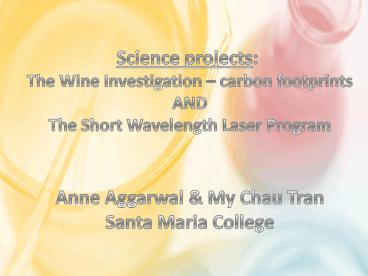Science projects: - PowerPoint PPT Presentation
1 / 9
Title:
Science projects:
Description:
The project description:- UV light generated from the xenon arc lamp penetrates through the wine and interacts with existing compounds. This light breaks down ... – PowerPoint PPT presentation
Number of Views:56
Avg rating:3.0/5.0
Title: Science projects:
1
Science projects The Wine Investigation
carbon footprints AND The Short Wavelength Laser
Program Anne Aggarwal My Chau Tran Santa
Maria College
2
The project description-
UV light generated from the xenon arc lamp
penetrates through the wine and interacts with
existing compounds. This light breaks down
existing molecules in wine and form new compounds
which are shown through the browning of wine,
theses new substances formed are called
Xanthylium cations pigments. This browning
process occurs at -480nm. It affects the color
and smell of wine which than leads to less
consumer appeal. Hence, ideas were taken from the
participants to explore the way the wine industry
could still have high consumer appeal but less
carbon emissions.
3
Projects Importance Reason for Investigation Its relevance to society
One disadvantage of wine would be the Indirect Contribution to Global Warming. Study of degradation of wine under ultra violet light. Monitor chemical changes using a UV-visible Spectrometer to work out the wavelength at which the absorbance is highest. Wine industry should initiate action to lower carbon footprints. The manufacture of green wine bottles has a high energy consumption as more energy is required to recycle them. Green wine bottles are expensive because due to their weight (Mainly the thickness of glass bottles). More energy is used to export these bottles from one place to another. Hence, more transportations costs. Exposing wine to high UV-lights will change its chemical properties like color, smell.
4
Results-
- The experiment shows that the absorbance of
molecules is at its greatest around the
wavelength of Ultra-Violet light (less than 400
nm). - This result can be useful for the overall
project-that is reducing carbon emission in the
wine industry. - Glass bottles especially the antique-green
colored emits an enormous amount of carbon
emission when they are produced and recycled. - The weight of the bottles is also of great
importance as it affects the amount of energy
required for transportation. - Thus, there have been many proposals saying that
by using lighter bottles and clear glass, the
wining industry can reduce their carbon
emissions. However this might affect the quality
and the degradation of wine.
5
UV- Vis spectrometer -
- Provides information -
- the color of molecules present in a solution
- can identify functional groups and is routinely
used in chemical and biochemical laboratories. - Samples are used in solution and are placed in a
small quartz cell. - A lamp which provides ultraviolet and visible
energy is used. Radiation across the whole range
is scanned by the spectrometer (200-800 nm). - A reference cell containing only solvent is used.
Light is passed simultaneously through the sample
cell and reference cell. The spectrometer
compares the light passing through the sample
with that passing through the reference cell. - The transmitted radiation is detected and the
spectrometer records the absorption spectrum
(Absorbance vs wavelength) by scanning the
wavelength of the light passing through the
cells. - The energies of light that are absorbed by the
molecules in solution indicates what species of
molecules are present. - If the same solution is measured over time the
spectra that are collected can tell you what is
happening to the molecules in solution.
6
- What made the experiences so unique?
- Not everyone gets this sort of opportunity
during school - We get to access the same opportunities and
equipment as scientists. - We get to talk and spend time with real
scientists. - We feel more involved with the issues of our
world. - We learn more experimental techniques like
spectrometers that we cannot do at school.
7
- What did I think of this way of learning?
- Peer learning can improve the overall quality of
student learning. - Group work provides an opportunity for students
to clarify and refine their understanding of
concepts through discussion and rehearsal with
peers. - Group work may reduce the workload.
- Group work can facilitate the development of
skills, which include - teamwork skills (skills in working within team
dynamics leadership skills) - analytical and cognitive skills (analyzing task
requirements questioning critically
interpreting material evaluating the work of
others) - collaborative skills (conflict management and
resolution accepting intellectual criticism
flexibility negotiation and compromise) and - organizational and time management skills
'Having to do group work has changed the way I
worked. I could not do it all the night before. I
had to be more organized and efficient
8
- How my views of science and scientists changed
- Perfect modeling is rare in science.
- Everyone despite who they are can do science.
- All different types of sciences are intertwined
and leads to many career pathways. - Science is about solving the worlds problems,
all sciences are relevant and interesting.
9
- Participants and mentors and acknowledgement
- ARC Centre of Excellence for Coherent X-Rays
Science. - Santa Maria College
- University of Melbourne Chemistry Department
- Professor Trevor Smith , Dr. Daniel Dias, Liisa
Smith - Akorn Educational Services
- Catholic Education Office Melbourne































